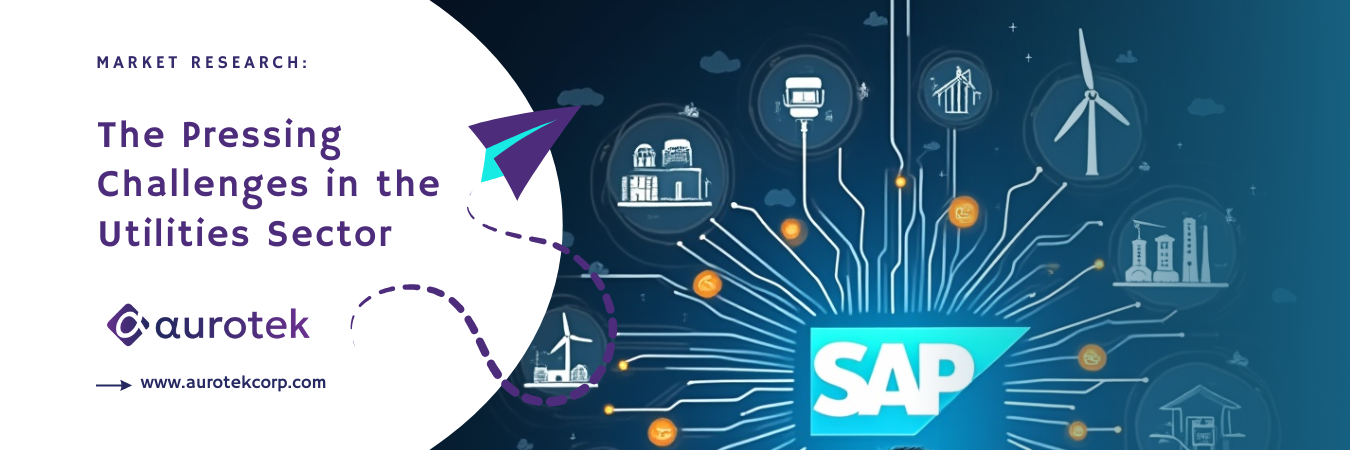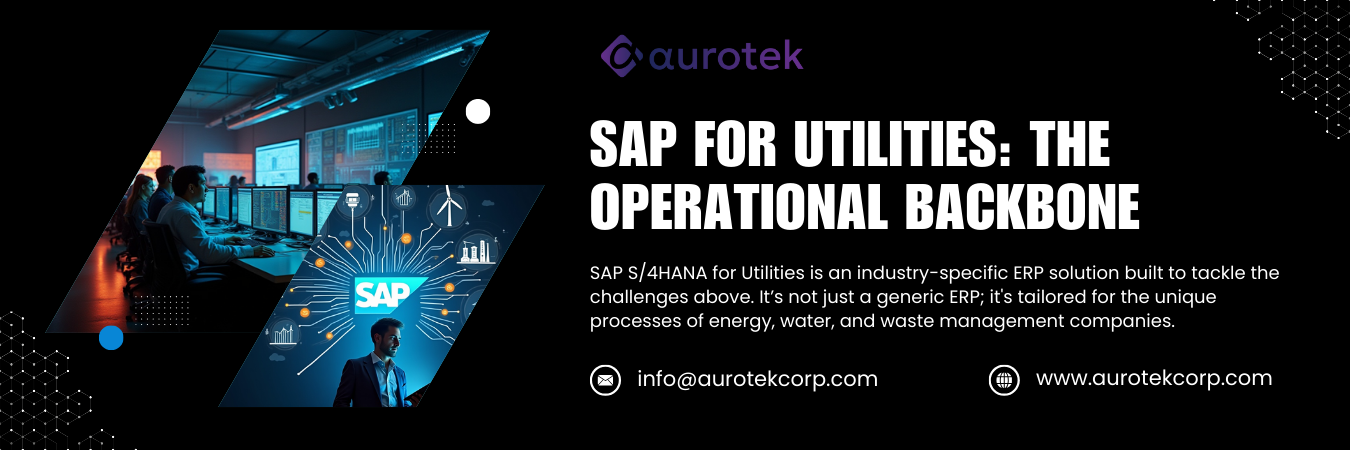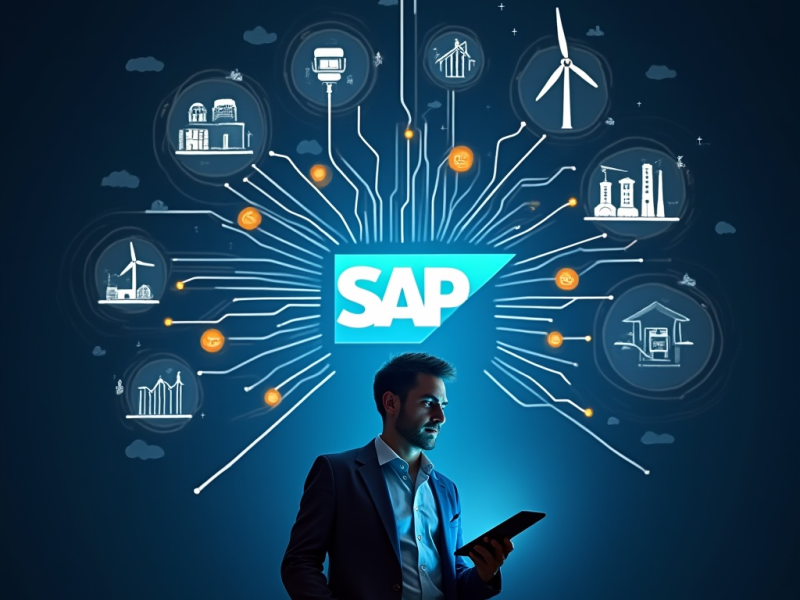This article explores the powerful synergy between three critical areas: SAP for Utilities, SAP for Data Analysis, and the overarching SAP Data and Analytics platform. We begin with market research highlighting the unique challenges faced by utility companies, demonstrating the urgent need for robust ERP and analytics solutions.
The article then delves into how SAP S/4HANA for Utilities optimizes core operations like smart meter integration, asset management, and customer engagement. Following this, we explain how SAP has transformed from a transactional system into a powerhouse for data analysis, detailing key tools and methodologies.
Finally, we introduce the modern SAP Data and Analytics suite, including SAP Datasphere and SAP Analytics Cloud, which unifies data landscapes to enable actionable, real-time intelligence. The conclusion provides a clear path for businesses seeking to leverage these technologies for a competitive advantage.
Content Pillars:
- Introduction to SAP’s Integrated Ecosystem
- Market Research: The Evolving Utilities Sector and Its Data Challenges
- SAP for Utilities: Optimizing Core Operations and Customer Experience
- SAP for Data Analysis: From Transactional System to Insight Engine
- SAP Data and Analytics: The Modern Unified Platform (SAP Datasphere & SAP Analytics Cloud)
- The Tangible Business Benefits of an Integrated SAP Approach
- Conclusion: Building a Data-Driven Future with SAP
Introduction: The SAP Ecosystem – More Than Just ERP
For decades, SAP has been the backbone of global enterprise operations, known for its powerful Enterprise Resource Planning (ERP) systems that integrate finance, HR, supply chain, and manufacturing. However, the digital age has transformed SAP from a system of record into a platform for intelligence. Today, keywords like SAP for data analysis and SAP data and analytics reflect this shift. Businesses are no longer just running their operations on SAP; they are mining it for insights, predicting trends, and driving innovation. This is particularly true in specialized sectors like energy and water, where “SAP for utilities“ has become essential for navigating market deregulation, renewable integration, and evolving consumer demands.
This article will guide you through how these three domains intersect to create a seamless flow from operational data to strategic insight.
Market Research: The Pressing Challenges in the Utilities Sector
The utilities industry is at a crossroads. Driven by climate change policies, technological disruption, and changing consumer behavior, the sector faces unprecedented challenges:

The Renewable Energy Transition
Integrating intermittent sources like solar and wind into a stable grid requires incredibly complex forecasting and load balancing. This shift demands a modernized grid management system that can dynamically respond to fluctuations in supply and demand. A robust SAP for Utilities solution provides the advanced analytics and real-time data processing capabilities essential for optimizing energy mix, ensuring grid stability, and maximizing the integration of renewable resources.
Aging Infrastructure
Managing and modernizing physical assets (pipes, lines, substations) is critical for reliability and safety, demanding predictive maintenance capabilities. Proactive replacement and repair strategies are essential to prevent service disruptions and ensure public safety. Implementing a comprehensive SAP for Utilities platform enables a shift from reactive to predictive asset management, leveraging IoT data and analytics to prioritize capital investments and extend the lifespan of critical infrastructure.
Smart Meter Data Deluge
Advanced Metering Infrastructure (AMI) generates terabytes of granular consumption data, creating both an opportunity for insight and a challenge for management. Utilities must be able to store, process, and interpret this data to derive actionable intelligence. The SAP for Utilities ecosystem is specifically designed to handle this data deluge, transforming raw meter readings into valuable insights for demand forecasting, personalized customer services, and operational efficiency.
Consumer Expectation Evolution
Customers now expect the same digital self-service experiences they get from retail and tech companies, pushing utilities to become more customer-centric. This includes transparent billing, outage alerts, and energy usage apps. Modernizing the customer experience is a core function of SAP for Utilities, which offers integrated customer engagement platforms that provide seamless, personalized interactions and help build loyalty in a competitive market.
This market landscape creates a clear commercial intent behind the search for SAP for utilities. Companies are actively seeking a transactional partner—a software solution that can directly address these pain points and modernize their core operations.
SAP for Utilities: The Operational Backbone
SAP S/4HANA for Utilities is an industry-specific ERP solution built to tackle the challenges above. It’s not just a generic ERP; it’s tailored for the unique processes of energy, water, and waste management companies.

Customer Engagement and Billing
It handles complex rate structures, including time-of-use pricing, net metering for prosumers (consumers who also produce energy), and streamlined billing for greater transparency. This capability is central to building customer trust and enabling personalized energy management programs. The SAP for Utilities solution empowers customers with self-service portals and detailed insights into their consumption, fostering a modern, participatory relationship and ensuring accurate, compliant billing even under the most complex regulatory frameworks.
Smart Meter Integration
The solution seamlessly integrates with head-end systems to process vast volumes of meter data, enabling accurate billing and providing customers with detailed usage portals. This ingestion of granular, interval data is the foundational step for advanced analytics and grid optimization initiatives. By leveraging the powerful in-memory computing of SAP for Utilities, companies can manage this data deluge in real-time, unlocking capabilities for dynamic pricing, outage management, and enhanced demand forecasting.
Asset Management
It allows for the end-to-end management of the asset lifecycle—from planning and construction to operation and maintenance. This is crucial for preventing failures and optimizing capital expenditure. The SAP for Utilities platform provides a single source of truth for all asset data, enabling predictive maintenance strategies that are informed by real-time IoT sensor data and historical performance. This integrated view allows for superior capital planning, risk mitigation, and the extension of asset useful life, ensuring both reliability and financial efficiency.
Workforce and Safety Management
It dispatches field technicians efficiently, ensures regulatory compliance, and manages safety permits, all integrated with financials and logistics. This integration is vital for maximizing crew productivity and ensuring every field operation is performed safely and in accordance with strict industry regulations. By utilizing SAP for Utilities, companies can automate scheduling based on real-time priorities and technician skill sets, track compliance certifications, and directly link field labor and materials costs to specific assets and work orders, closing the loop on operational finance.
For a utility company, implementing SAP for Utilities is a strategic commercial decision to enhance operational efficiency, reduce costs, and improve regulatory compliance.
SAP for Data Analysis: Unleashing the Insight Within Your ERP
The transactional data generated by SAP for Utilities (or any SAP ERP) is a goldmine. The search term “SAP for data analysis” signifies the desire to tap into this resource. Historically, analyzing SAP data required complex extraction and loading into separate data warehouses. Today, with SAP HANA as the in-memory database underpinning modern SAP systems, analysis can happen in real-time.
Key tools and concepts for analyzing data directly within the SAP ecosystem include:
- SAP HANA: The engine that makes it possible. Its in-memory computing allows for blindingly fast aggregation and calculation on live operational data.
- SAP Query & QuickSizer: Tools for business users to create basic reports without deep technical knowledge.
- ABAP Core Data Services (ABAP CDS): A more advanced framework for developers to create semantically rich data models that expose data for consumption by analytics tools.
- Embedded Analytics: SAP S/4HANA comes with pre-built, real-time analytical apps for areas like procurement, sales, and inventory management, allowing users to analyze data directly within the transactional context.
This capability transforms every business user into a potential data analyst, enabling them to answer critical questions about profitability, operational bottlenecks, and customer behavior without leaving the SAP environment.
SAP Data and Analytics: The Unified Modern Platform
While embedded analytics is powerful, most enterprises have data scattered across SAP and non-SAP systems (e.g., Salesforce, AWS, custom databases). This is where the broader SAP Data and Analytics platform comes in, representing the cutting edge of SAP’s strategy.
This unified approach is powered by two flagship solutions:
- SAP Datasphere: This is the data warehouse and fabric layer. It allows companies to access, model, and integrate distributed data without moving it physically. It preserves the business context and semantics of data from SAP for utilities applications, making it “business-ready” for analysis. This solves the classic problem of losing meaning when data is extracted and transformed.
- SAP Analytics Cloud (SAC): This is the visualization, planning, and predictive engine. SAC connects directly to SAP Datasphere and live SAP systems to create interactive dashboards, run advanced planning and budgeting scenarios, and leverage built-in machine learning for forecasting and automated insights.
Together, they form a cohesive platform that democratizes data access, ensures a “single source of truth,” and empowers organizations to move from descriptive analytics (“what happened”) to predictive (“what will happen”) and prescriptive (“what should we do”) analysis.
The Tangible Business Benefits of an Integrated Approach
Combining SAP for Utilities with a robust SAP Data and Analytics strategy yields significant ROI:

- Predictive Maintenance: Within the SAP for Utilities framework, predictive maintenance transforms asset management from a reactive, schedule-based cost center into a proactive, value-driving operation. The solution integrates seamlessly with IoT sensors embedded in critical grid assets—such as transformers, pumps, and circuit breakers—continuously feeding operational data (e.g., temperature, vibration, load stress) into the SAP HANA platform. Here, powerful in-memory computing analyzes these vast datasets in real-time, using machine learning algorithms to identify subtle patterns and anomalies that precede a failure. This capability, central to a modern SAP for Utilities deployment, allows maintenance teams to receive automated alerts and detailed work orders before a breakdown happens. The result is a dramatic reduction in unplanned downtime, extended asset lifespans, and optimized maintenance budgets by preventing costly emergency repairs and catastrophic failures.
- Customer Churn Prevention: In a competitive market, retaining customers is as crucial as acquiring new ones. SAP for Utilities provides the foundational customer and billing data that becomes the source for advanced analytics aimed at churn prevention. By leveraging the integrated analytics capabilities within the SAP ecosystem, utility companies can develop sophisticated customer propensity models. These models analyze a combination of historical payment patterns, service call history, consumption changes, and engagement with digital portals (like web or app logins) to score each customer on their likelihood to switch providers. This data-driven approach, powered by SAP for Utilities, empowers marketing teams to move from broad, generic campaigns to highly targeted retention efforts. They can automatically trigger personalized offers, loyalty programs, or proactive check-ins for high-risk segments, significantly improving customer satisfaction and reducing churn rates.
- Energy Theft Detection: Non-technical losses from energy theft or meter tampering represent a significant revenue drain for utility providers. Tackling this issue effectively requires more than occasional manual inspections; it demands intelligent, continuous analysis of consumption data. The robust data foundation provided by SAP for Utilities, especially its handling of massive smart meter data streams, is critical for this. Advanced algorithms within the SAP analytics suite can be deployed to scrutinize usage patterns for every meter, comparing them against established benchmarks for similar customer profiles, time of day, and seasonal norms. The system flags meters with anomalies, such as a sudden dramatic drop in usage, consistent usage below expected thresholds, or patterns indicating bypass methods. This analytical power turns SAP for Utilities into a powerful fraud detection tool, enabling investigators to focus their efforts on the most probable cases, recover lost revenue, and enhance the overall security of the distribution network.
- Integrated Financial Planning: Traditionally, financial planning and operational forecasting have existed in separate silos, leading to inaccurate budgets and misaligned strategies. SAP for Utilities shatters this silo by creating a live digital thread between operational data and financial models. Through platforms like SAP Analytics Cloud, financial planners can directly integrate real-time and forecasted operational data—such as predicted energy demand based on weather patterns, planned asset maintenance schedules, or projected customer growth—into their financial planning and analysis (FP&A) models. This integration ensures that financial forecasts for revenue, capital expenditures, and operational costs are grounded in operational reality. The strategic advantage of this approach within SAP for Utilities is unparalleled accuracy and agility in planning, allowing executives to perform dynamic what-if scenarios and make data-driven investment decisions with greater confidence.
Conclusion: Building a Data-Driven Future with SAP for Utilities
The journey from searching for SAP for utilities to implementing a full SAP data and analytics strategy is a journey from operational efficiency to strategic dominance. It begins with a solid transactional foundation—an industry-specific ERP that runs your business. The next step is to empower your teams with the tools for analysis, unlocking the value trapped in your processes. Finally, by adopting a unified analytics platform, you break down data silos and create a holistic, real-time view of your entire enterprise.
For any utility company or large enterprise running SAP, the message is clear: your most valuable asset is not just the software, but the data it generates. By investing in this integrated approach, you transform your organization from a utility provider into an intelligent, data-driven energy partner, ready to thrive in the complex landscape of the future.

